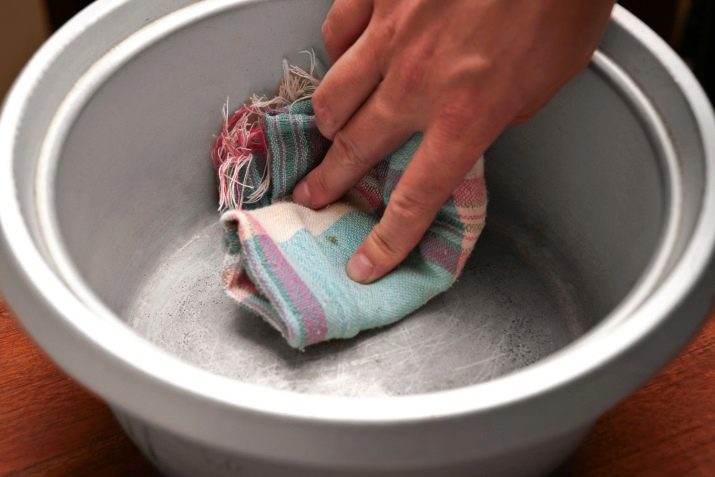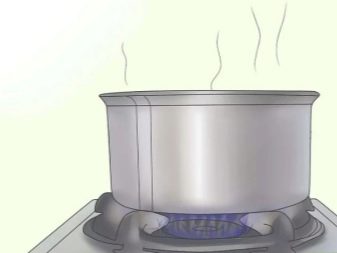Aluminum pans are an item present in the kitchen of every person. Cookware made of this metal is lightweight and allows you to quickly heat food. In order for aluminum products to please you for more than one year, you need to take care of them and know how to clean them at home.

Causes of Darkening
Aluminum utensils, like any other, are susceptible to the formation of soot. Improper handling of such products quickly makes them unsightly. Pollution on aluminum can be formed not only due to burnt food or grease on the outside, a dark coating may form on the surface inside the pan for several reasons:
- cooking potatoes in a peel;
- cooking dishes with sourness (cabbage soup with sauerkraut);
- prolonged boiling of water without adding salt.

Ways to remove black from the surface of the dishes
It is not recommended to wash aluminum with abrasive substances, especially for polished surfaces. To clean the scale, you can use a soft cloth and a non-aggressive cleaning agent (without alkali and acid). You can not use soda for cleaning, the alkali contained in it will adversely affect the state of the metal.
Among the most popular and affordable methods of removing burning from pots, the following can be distinguished:
- salt;
- acetic and citric acid;
- ammonia;
- Activated carbon;
- apples
- milk serum;
- soap.


Low pollution cleaning options
To clean the dirt that has appeared on the bottom and walls of the pan recently, you can use no aggressive agents. The improvised means will help restore the original shine to the dishes:
- Non-aged scale can be removed with whey. Pour the product into the pan and leave for 24 hours. Then wash with a soft cloth. You can also use kefir or pickle brine. Pour into contaminated dishes for 60 minutes, then drain. Wash the pan with a soft sponge and detergent.
- Light dirt on the outside and inside of the pan will help pick up sour apples. They need to be cut and slices strongly rub the blackened areas.
- Instead of apples, you can use lemon. Grate and put the resulting slurry in gauze. Grate the darkened places of the pan well and leave for 50 minutes. Wash the aluminum product with a soft sponge and detergent for dishes.
- Effective against dark plaque. Peel the two onion heads, lower them into the pan and cook for half an hour. The whole raid will do.
- You can use laundry soap. Finely grate, dip in water and boil for 20 minutes. When the water has cooled, wash the pan with a sponge.




The listed funds are effective in eliminating mild and not aged traces of scale. If the dishes are very dirty, it is better to use acetic acid, sodium chloride or ammonia.
Strong Plaque Removal
Food burned during the jam from the bottom of the pan can be removed with salt. To do this, you must:
- Pour the dishes with cool water. Allow to stand for 10 minutes.
- Drain, pour salt.
- Leave to soak for several hours.
- Wipe off food debris with a dishwashing gel.
To remove dark plaque on the inner walls, a water-salt solution will help:
- Mix the ingredients in equal proportions.
- Apply the mixture to a soft sponge.
- To rub places of a scum.


Aged traces of soot can be removed with household soap and ammonia. The mixture is prepared as follows:
- Grind half a bar of soap.
- Add water.
- Add a tablespoon of ammonia.
- Boil for 15 minutes.
- Cool.
- Wash the pan.
During cleaning, access to fresh air is required. During boiling ammonia, vapors harmful to human health are released.

Removes carbon deposits well a mixture of PVA and laundry soap (1/3 of the bar is enough). Pour the mixture into the pan, boil for half an hour. Places of darkening rub with a washcloth. Wash the pan well.
With long-term traces of scale that no means can clean, it will help to cope. a mixture of laundry soap, soda ash and silicate glue. This recipe does not negatively affect the properties of the metal, but it perfectly cleans darkened pots. It is necessary to prepare 10 liters of water, a piece of laundry soap, a glass of soda. Grind the soap, immerse it in water, add soda and glue there. Heat over high heat, stirring until the soap dissolves. Immerse contaminated dishes in the mixture, reduce the heat after boiling. Cover the container.
The boiling time depends on the degree of contamination of the pots. On average, the procedure takes one to two hours. After completing the procedure, remove the pots and clean them using a synthetic sponge.
You can use an unusual way to remove traces of scale: put an aluminum pan in the freezer for 60 minutes. Wash with dish detergent.


Activated charcoal will help clean milk residues from aluminum. To do this, you must:
- Crush 4 tablets into powder;
- cover the bottom of the pan with it and leave for 30 minutes;
- pour the dishes with cold water. Allow to stand for another half hour (along with coal powder);
- wash the pan with a sponge with dishwashing gel.
If soot is already very eaten up, 9% table vinegar will help to cope with it:
- Dilute the vinegar in water (1 cup per 1 liter) and pour the pan into the resulting solution.
- Boil.
- Cool, wash with a sponge and soapy water.
When using this method of cleaning aluminum pans, safety measures must be observed: the window must be open, otherwise vinegar vapors can adversely affect the state of health.



With frequent use of an aluminum pan, you will notice that a calcareous deposit forms on its walls and bottom. Citric acid will help to remove it:
- Pour the pot with water.
- Boil.
- Add 2 tablespoons of citric acid.
- Boil for 15 minutes.
- Allow to cool.
- Wash the pan with dishwashing detergent.

Care
New aluminum cookware requires maintenance before use. It must be washed to remove technical grease. To do this, wash the product with a soft sponge with a dishwashing detergent, rinse with cool water. It is good to calcine the pan so that an oxide-salt film appears on its walls. It will protect aluminum from oxidation and prevent harmful compounds from entering the food.
An aluminum pan should be calcined as follows:
- wash the product well, allow to dry completely;
- pour vegetable oil at the bottom;
- add a tablespoon of salt;
- calcine for 5 minutes (the smell of heated oil will become a guide);
- allow the dishes to cool and wash with a sponge with soapy water.

The aesthetic appearance of the pan and its service life is directly related to the care of the metal. When washing the product, the following rules must be followed:
- You can wash the pan only when it has cooled to room temperature.
- If the food is burnt, the dishes must be immediately soaked in warm water with the addition of detergent. Leave to soak for an hour or two. After these steps, washing the pan will be much easier.
- Aluminum products must be washed by hand, not in the dishwasher.
- The sponge or washcloth should be soft, without interspersing abrasive particles.
- The washing gel must be thoroughly washed off the inside and outside of the pan.
- Chemical products purchased at the store must have the indication “for aluminum utensils”. Among them, you need to choose substances that have a neutral pH. In the name of such funds often write "gel for cleaning metals." Due to the multicomponent composition, such substances quickly and efficiently remove strong contaminants. After using them, you must very thoroughly wash and rinse the dishes.
- An aluminum product must not be washed under a hot stream of water; this can lead to deformation.
- Once a week, it is necessary to carry out preventive cleaning of dishes from darkening. To do this, you need a foam sponge and baking soda. If cleaning is carried out regularly, in the future there will be no need to use multicomponent means for removing obsolete scale deposits.



Operational Features
So that aluminum pans do not fail for a long time, The following recommendations should be followed:
- Try to cook less sour-milk soups and other dishes in a pan.
- After the dish is cooked, it must be transferred to a container. From prolonged contact with food, aluminum begins to darken, and the food takes on a taste of metal.
- In aluminum utensils, you must not make starter cultures or salting. When interacting with an acidic environment, substances are released that adversely affect human health.
- To prevent scale from appearing on the walls of the pan, you need to cook food over low heat.
- To mix the ingredients, it is better to use a paddle made of silicone, plastic or wood. They will not scratch the metal.
- To prevent the formation of soot, food should be stirred regularly.


Any methods of cleaning aluminum utensils require a certain amount of time and compliance with safety rules. The selection of recipes is so diverse that every housewife can find in the home arsenal at least a few necessary ingredients and clean the pots with improvised means.If you handle aluminum cookware correctly and carefully, it will delight you with its beautiful appearance and excellent functional characteristics for more than one year.
For more details on how to clean aluminum pans from soot, see the next video.










